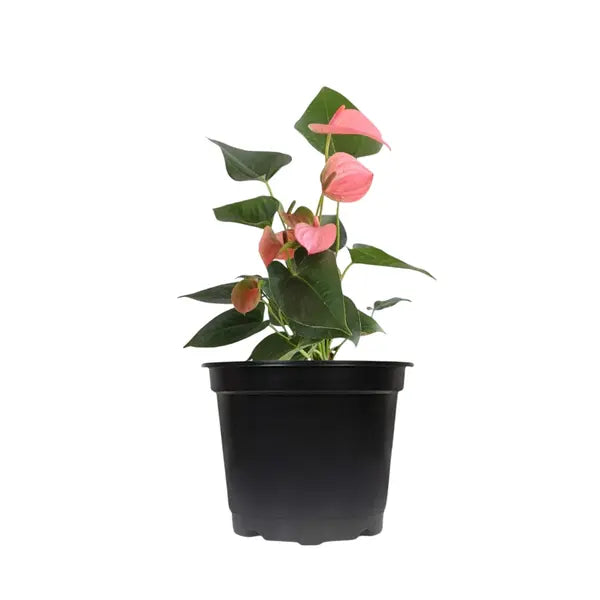
Anthurium Baby Pink - Double Shoot
Selling Size : Please Choose | Pot Included | Secure Packing
The Anthurium Baby Pink shares very similar care requirements with its 'Lilli Pink' counterpart, as both are varieties of Anthurium andraeanum, commonly known as the Flamingo Flower or Laceleaf. The key is to mimic their natural tropical rainforest environment.
Here's a detailed care guide for your Anthurium 'Baby Pink':
1. Light:
Bright, indirect light is ideal. This is crucial for healthy growth and abundant blooms.
Place it near a window that receives bright, filtered light throughout the day. A north or east-facing window is often perfect. If you have a south or west-facing window, place the plant a few feet back or use a sheer curtain to diffuse the direct sunlight.
Avoid direct sunlight as it can scorch the glossy leaves, leading to brown patches.
Low light conditions will result in leggy growth and significantly fewer, or no, flowers.
2. Watering:
Water when the top 50-75% (or 2-3 inches) of the soil feels dry to the touch. You can test this by sticking your finger into the soil.
Water thoroughly until water drains out of the bottom of the pot.
Crucially, do not let the plant sit in standing water, as this leads to root rot, which is a common killer of Anthuriums. Always empty any excess water from the saucer.
Yellowing leaf tips can indicate overwatering, while brown, crispy leaf tips may suggest underwatering.
Reduce watering frequency during the cooler, darker winter months when the plant's growth slows down.
Using filtered or distilled water, or tap water that has sat out for 24 hours (to allow chlorine to dissipate), can be beneficial.
3. Humidity:
As a tropical plant, the Anthurium 'Baby Pink' thrives in high humidity, ideally between 60-80%.
To provide adequate humidity:
Mist the foliage regularly (daily or every couple of days), especially in dry climates or during winter heating. Avoid misting the flowers directly, as this can cause spots.
Place the pot on a pebble tray filled with water. Ensure the bottom of the pot is elevated above the water to prevent root rot.
Use a room humidifier nearby, especially if you have several tropical plants.
Group it with other plants, as transpiration from multiple plants can create a more humid microclimate.
Bathrooms or kitchens, if they receive adequate light, can be good locations due to naturally higher humidity.
4. Temperature:
Maintain average to warm indoor temperatures, ideally between 18-29°C (65-85°F).
Avoid sudden temperature fluctuations and cold drafts. Keep the plant away from open windows, air conditioning vents, or heating vents.
Temperatures below 15°C (60°F) can cause damage to the plant and inhibit blooming.
5. Soil and Potting:
Anthuriums are often epiphytic, meaning they naturally grow on other plants rather than in dense soil. Therefore, they need a loose, airy, and well-draining potting mix that mimics their natural growing conditions.
A good mix usually consists of:
50% orchid potting mix (which often contains fir bark, charcoal, and perlite)
50% regular good quality houseplant potting mix
You can also create your own mix using ingredients like coco coir/peat, perlite, horticultural charcoal, and some pine bark.
The soil pH should be slightly acidic, around 4.5-5.5 pH.
Ensure the pot has ample drainage holes.
Repot every 2-3 years, or when the plant becomes root-bound (roots are circling the pot or growing out of drainage holes). They don't mind being slightly pot-bound.
6. Fertilizer:
Feed your Anthurium 'Baby Pink' monthly during the spring and summer growing season (its active growth period).
Use a balanced liquid houseplant fertilizer diluted to half or quarter strength.
To encourage more blooms, you can use a fertilizer with a higher phosphorus (P) number (the middle number in the N-P-K ratio).
Do not fertilize in the late fall and winter when the plant is dormant or growing slowly.
Always apply fertilizer to damp soil to prevent root burn.
7. Pruning:
Pruning is mainly for maintenance.
Remove any yellowing, browning, or dead leaves by snipping them off at the base of the stem with clean, sharp scissors or pruning shears.
Snip off spent or faded flowers (the colorful spathes and their central spadix) at the base of their stem. This encourages the plant to produce new blooms.
You can also prune to maintain shape if the plant becomes leggy, but always leave a few healthy leaves.
8. Toxicity:
Like most Anthuriums, the 'Baby Pink' variety is toxic to humans and pets if ingested. It contains calcium oxalate crystals that can cause irritation to the mouth, throat, and digestive system. Keep it out of reach of children and pets.
The sap can also cause skin and eye irritation, so it's a good idea to wear gloves when handling the plant if you have sensitive skin.
9. Pests and Diseases:
Anthuriums are generally resistant to pests, but keep an eye out for common houseplant pests like mealybugs, spider mites, and aphids.
Inspect your plant regularly. If you spot pests, treat them promptly with insecticidal soap or neem oil.
The most common disease issue is root rot, almost always caused by overwatering. Ensure proper drainage and allow the soil to dry out sufficiently between waterings.
By providing these consistent care conditions, your Anthurium 'Baby Pink' will flourish and add a charming touch of color to your indoor space!

